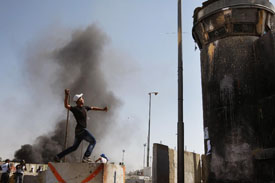RAMALLAH, West Bank -- Muhammad Assaf was hurling rocks at Israeli soldiers at the border checkpoint Thursday night. He remembers hunkering down with his friends, teens like him, against a tall concrete security barrier that separates Israelis from Palestinians. Then, he said, two Israeli soldiers appeared -- and started firing live rounds at them.
Assaf was shot in the right leg. On Friday, as the violence spread to other parts of the West Bank, he was walking with crutches -- but without regrets. He was at the protest "because of Gaza," he said with pride. The anti-Israel protest that began Thursday, one of the biggest in years in the West Bank, marked his initiation into the Palestinian resistance. Assaf is 15.
A new generation of young Palestinians is emerging to battle Israel, with anger fueled by social media, smartphones and websites that provide searing news and images round-the-clock.
Most were not yet born or were toddlers during the second Palestinian intifada, or uprising, of the early 2000s, a brutal period when Palestinian militants dispatched suicide bombers to kill Israelis and Israel cracked down with tanks, airstrikes and targeted killings. And they were too young to fight when Israel began offensives against Hamas militants in the Gaza Strip in 2009 and 2012.
Now, in their mid- to late-teens, the youths are coming of age in an era when technology provides a highly personalized, ringside view of the violence, and YouTube videos, photo-sharing apps and militant-run television channels transform fighters into heroes and suicide bombers into immortals.
Palestinian teenagers confronting Israeli soldiers are not a new phenomenon. According to B'Tselem, an Israeli human-rights group, from January 2005 to December 2010, at least 835 Palestinians ages 12 to 17 were arrested and tried in military courts in the West Bank on charges of stone throwing.
This time, though, some Palestinians said things were different.
"This is the first time I have seen this many children demonstrating," said Muayed Debah, 21, an ambulance worker whose job was to retrieve the dead and injured at the Thursday protest.
Thousands of Palestinians were throwing rocks and Molotov cocktails at Israeli security forces, and burning tires at the Qalandia checkpoint straddling Israel and the West Bank, where restiveness is rising as casualties and violence mount in Gaza.
Israel's military acknowledges that its soldiers used live rounds, rubber bullets and lobbed tear gas canisters at the crowds. The military said it did so in self-defense, because soldiers felt their lives were threatened.
Debah said he carried out 10 injured teenagers, as young as 15, before two bullets struck his own arm and upper left leg. The one Palestinian shot dead Thursday night was Muhammad al-Araj, a 17-year-old cook at a popular restaurant in Ramallah. Five more Palestinians were killed Friday in West Bank protests.
"The Israelis were using live ammunition to kill, and they didn't care if they hit kids," Debah said as he lay in a hospital bed at Ramallah's main hospital, blood seeping through his bandages.
Israel's military has repeatedly said that it does not target children.
A medical official at the hospital said 137 protesters were treated for injuries, many for bullet wounds, while 60 others were discharged with minor injuries. Many of the casualties were youths, ages 16 to 20, said surgeon Madi Hamad.
"The situation is creating a new generation of resistance fighters," Hamad said, minutes after he had operated on a youth who was shot near the heart. "And this will pave the way for a third intifada."
Downstairs, Wajdi Khatab, 17, was hobbling on one leg; the other one had a bullet wound. He has two cousins in Gaza, but he has never seen them. During the second intifada, Israel stopped allowing Palestinians in the West Bank to travel freely to Gaza, and vice versa.
So Khatab connects with his cousins and other Gazans almost daily through Facebook, WhatsApp and other social media applications. Through this, he said, he realized how much Palestinians in Gaza are suffering. And that made him decide to join Thursday's demonstrations, he said.
The next day, thousands mourned al-Araj at his funeral. His father, Ziad al-Araj, said his son was deeply disturbed by the images of "dead children and women" he saw on television.
"Muhammad wanted revenge for Gaza," his father said. "He would ask, 'Why I am not in the resistance? Why I am not defending the honor of these women and children?' "
Assaf and his friends also went to pay their respects to al-Araj. They said they understood why he risked his life.
Assaf shares his name with the popular Gazan winner of last year's Arab Idol, the Middle East's version of the American talent program. But ask Assaf who are his icons, and he says Hamas.
"They are heroes," Assaf said, as his friends nodded.
The group included 10-year-old Mustafa, who said that he, too, had taken part in Thursday's protests to show "solidarity with the children of Gaza."
When asked if he was scared during the mayhem, Mustafa replied like any child likely would in front of his pals: "I was not frightened."
A Section on 07/27/2014

